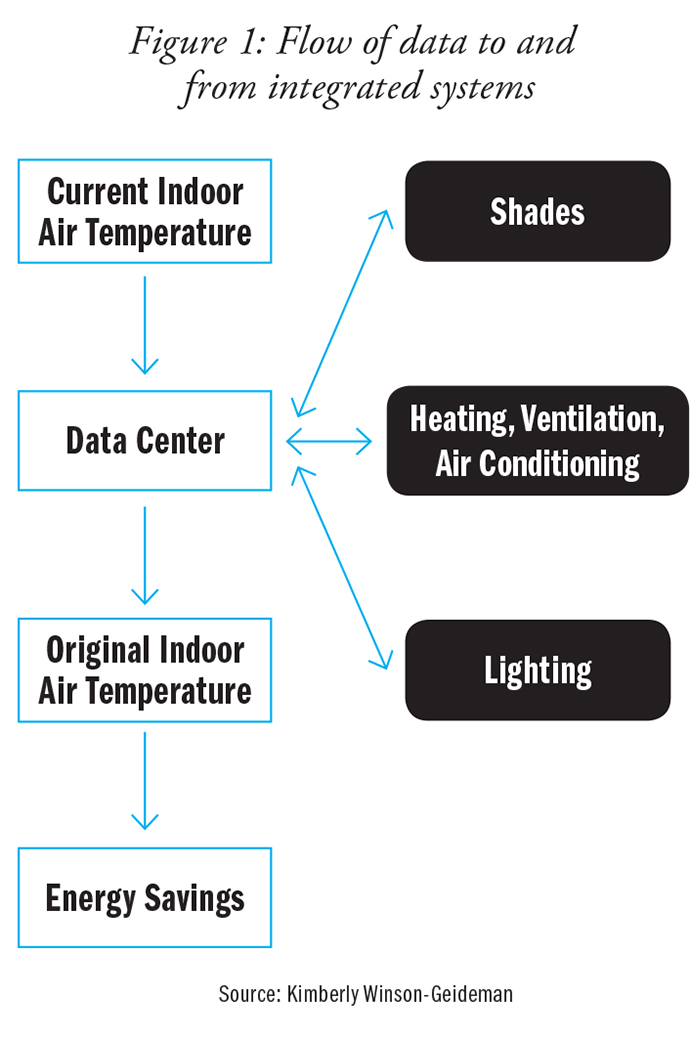In "The Office Property and Big Data Puzzle: Putting the Pieces Together," published by the NAIOP Research Foundation in August, Kimberly Winson-Geideman, Ph.D., senior lecturer in property at the University of Melbourne in Australia, explores how big data improves a building’s operational efficiencies, and how landlords can use big data effectively to attract and retain tenants. For the full 32-page report, visit www.naiop.org/Research. Here, by permission of the NAIOP Research Foundation, we present an excerpt focused on how big data innovation may influence office design and layout, as well as corporate location decision-making. — Editors
Attracting and retaining tenants is imperative to an investor’s bottom line and, in the era of big data, involves a focus on effectiveness along with the efficiencies generated through the use of integrated HVAC and network-based security systems. Creating and maintaining spaces that enhance the tenant experience, improving productivity and developing a cohesive working environment are examples of the potential benefits big data can bring. Much of this potential is being sourced from our seemingly constant companion, the smartphone.
The proliferation of smartphones means that we now have more detailed information on tenants, potential customers and clients than ever before. Big data tells us where people congregate, when they move through buildings, where they came from and in some cases why they were there. Retail is leading this charge as public Wi-Fi and other systems in shopping centers track shopper movements, capturing location information (even down to which aisle the shopper is occupying) to target advertising and inform tenant placement.
The office sector can realize benefits similar to those seen in retail. From the moment a tenant uses an access card to enter a building, the system can track his or her movements to help understand how tenants use the building. This information, combined with predictive modeling, can answer questions regarding the type of space needed, where it should be positioned, and when it is most likely to be used. Collaborative space, quiet areas and enclosed offices can be located in the most efficient and effective areas of the building relative to the needs of the tenant. For example, smart bathrooms track peak use to save on custodial costs. Sensors collect data on restroom visits and use that data to predict when the restrooms will need to be serviced. Smart ceilings, containing movement and heat sensors, provide real-time data on occupancy. The data allow property managers to provide space use and analytics to existing tenants, as well as digital building navigation.
The author’s conversations with several property managers indicated that they have a strong desire to use data to know more about how tenants occupy buildings (e.g., the locations and times of day that tenants gather in buildings). They also want to use evidence-based information to help make decisions about improving and investing in common spaces, determining peak occupancy hours, analyzing parking use and determining the amount of foot traffic in and around a building. Although landlords are generally comfortable with collecting and using non-personalized data to improve operational efficiencies, privacy concerns, along with uncertainty about how to analyze data, have most likely delayed widespread application of tenant-tracking technology. A property manager commented, "The technology to enable data collection has advanced faster than the ethical, legal and moral requirements discussions."
Decisions Can Use More Detailed Analysis
Locating and acquiring sites for purchase or lease that meet long-term tenant needs can be aided by the incorporation o f big data into advanced analytic programs that predict macroeconomic trends, demographic shifts, real estate prices and workforce accessibility.
Health care is one example of an industry using this technology to predict demographic shifts that inform site selection and leasing decisions earlier and more cost-effectively. The industry follows cohorts to understand where their best patients are through an examination of health care use, health expenditures, insurance coverage and source of payment.

The collection and aggregation of real estate data have become an industry unto itself, with companies such as LoopNet, Real Capital Analytics and CoStar among the first to see the value in collecting, standardizing and automating commercial property data such as transaction prices, cap rates, concessions and operating expenses. These companies have progressed from simply collecting, aggregating and disseminating data to creating their own set of proprietary metrics that can be incorporated into strategic decision-making.
These new aggregators exemplify the first wave of data marriages and nuanced analytics of the big data era. Big data also is spurring new technologies and disciplines that are affecting the real estate industry.
For example, blockchain technology will have an increasingly larger role in data management and property transactions.
The need for job positions such as data scientists, data stewards and data visualizers will continue to grow as companies take stock of their data sets.
Office buildings will most likely become equipped with more sophisticated technologies that will not only monitor energy use but also have broader applications that give landlords greater knowledge of how their building is (or is not) being used by tenants. Furthermore, the aggregation of complex data sets, driven by machine learning and predictive analytics, will affect real estate investment research. For example, how can complex and diverse data sets merge to evaluate investment decisions and improve the investment performance of an office building? Can big data help determine the ideal location of an office building, either now or several decades into the future?
Commercial real estate firms of all sizes can no longer expect to remain at the leading edge of their industry unless they begin to harness the potential of big data and its associated technologies. Integrating big data into an industry based on local information and personal relationships will be gradual, but companies that embrace the possibilities of big data will reap powerful advantages.


